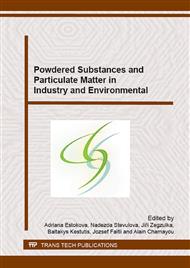p.57
p.65
p.71
p.77
p.88
p.94
p.102
p.108
p.114
The Ability of Slag-Portland Cement Composites to Withstand Aggressive Environment
Abstract:
The use of separately ground blast-furnace slag, added at the mixer as a replacement for a portion of the Portland cement, has gained increasing acceptance in recent years. The effects of partial replacement of Portland cement with ground slag on the properties of hardened concrete have been extensively investigated and reported. Both laboratory testing and field experience have shown that properly proportioned slag-Portland cement concretes have the improved resistance to sulfates and seawater compared to regular Portland mixes. The paper is focused on the effects of sulfur-oxidizing bacteria Acidithiobacillus thiooxidans on concrete mixtures with addition of ground granulated blast furnace slag compared to mixture without any additives. The concrete specimens with 65 and 75 % wt. addition of antimicrobial activated granulated blast furnace slag as durability increasing factor as well as without any addition were investigated in laboratory during the nine 7-day cycles. A laboratory study was conducted to comparison the performance of concrete samples in terms of a concrete deterioration influenced by the leaching of calcium and silicon compounds from the cement matrix. The changes in the elemental concentrations of calcium and silicon ions in leachates were measured by using X – ray fluorescence method. The pH values were measured and evaluated after each cycle. The concrete specimen with 65 % wt. addition of antimicrobial activated granulated blast furnace slag was found to have the best leaching performance of calcium ions than other samples. The final concentration of Si ions in leachate of concrete specimen with 75 % wt. addition of antimicrobial activated granulated blast furnace slag affected with bacteria Acidithiobacillus thiooxidans (4.614 mg/g of concrete sample) was observed to be 1.263 times lower than reference sample without any additives. The higher resistance of concrete samples with the addition of antimicrobial activated granulated blast furnace slag to the aggressive environment was confirmed.
Info:
Periodical:
Pages:
88-93
Citation:
Online since:
October 2015
Authors:
Keywords:
Price:
Сopyright:
© 2016 Trans Tech Publications Ltd. All Rights Reserved
Share:
Citation:


